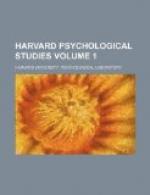General average: Figure, 34.03 sec.; vertical lines, 36.40 sec.
Series No. XIII.—In this series, also, both the figures of each pair were constituted of the same elements; that is to say, both were linear, and presented the same extent of surface (granite-gray), with the same length of line, the total length of the lines in each figure being twenty centimeters and the breadth of the lines being three millimeters. But while the lines of one figure were connected so as to form a continuous boundary, the lines of the other figure were all vertical, with equal interspaces. And, as in the last preceding series, the two figures were formed by a different but symmetrical arrangement of the same lines.
As before, the advantage is on the side of the disconnected lines. In this case, however, it is very slight, the general averages showing 34.03 seconds for the completed figure, as against 36.40 seconds for the lines. This reduction in the difference of the averages is probably to be explained by the reduced complexity in the arrangement of the lines. So far as they are all parallel they would not be likely to give rise to great diversity of movement, though one subject does, indeed, speak of traversing them in all directions. In fact, the completed figures show greater diversity of direction than the lines, and in this respect might be supposed to have the advantage of the lines. The notes suggest a reason why the lines should still prove the more persistent in ideation. “The lines appealed to me as a group; I tended always to throw a boundary around the lines,” is the comment of one of the subjects. From this point of view the lines would form a figure with a content, and we have learned (see Series No. VI.) that a space with a varied content is more effective in ideation than a homogeneous space of the same extent and general character. And this unity of the lines as a group was felt even where no complete boundary line was distinctly suggested. “I did not throw a boundary around the lines,” says another subject, “but they had a kind of unity.” It is possible also that from the character of their arrangement the lines reinforced each other by a kind of visual rhythm, a view which is supported by the comments: ’The lines were a little plainer than the figure;’ ‘figure shadowy, lives vivid;’ ’the figure grew dimmer towards the end, the lines retained their vividness.’
On the whole, however, the chances are very nearly equal in the two cases for the recurrence of the image, and a comparison of this series with Series No. XII. cannot leave much doubt that the greater effectiveness of the lines in the latter is due to their greater complexity. In view, therefore, of the fact that in both series the objects are all linear, and that the two series differ in no material respect but in the arrangement of the disconnected lines, the circumstance that a reduction in the complexity of this arrangement is attended by a very considerable reduction in the power of the lines to recur in the image or idea is a striking confirmation of the soundness of our previous interpretation.




